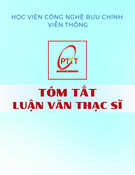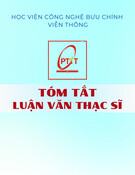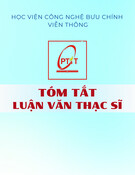
INCIDENCE AND EFFECT OF
MELOIDOGYNE INCOGNITA
(NEMATODA: MELOIDOGYNINAE) ON
BLACK PEPPER PLANTS IN VIETNAM
K.U.Leuven, Belgium
Dotoral thesis by Trinh Thi Thu Thuy, October
2010
Sumary
Pepper produced by black pepper plants (Piper
nigrum L.) is popularly considered as the “king
of spices”. Black pepper has become one of the
most important agricultural products of
Vietnam. Today, Vietnam is a worldwide the
leading producer and exporter of black pepper.
Plant protection is very important for pepper
production because pests and diseases
pathogens are major causes of the reduction in
yield and quality of pepper crops. One of these
pests pathogens are the root-knot nematodes
(Meloidogyne spp.).
In Vietnam, almost nothing is known about the
incidence of root-knot nematodes on black
pepper plants, their effect on plant growth and
yield, their interaction with soil-borne fungi
and their relationship with the occurrence of
yellowing of leaves of black pepper plants.
Therefore, the general objectives of our study
were to elucidate the incidence and effect of
Meloidogyne incognita on black pepper plants
in Vietnam and their interaction and
relationship with the incidence of soil-borne
fungi and yellowing of leaves of black pepper
plants.
In the first part of our study (Chapter 2), the
plant-parasitic nematodes associated with black
pepper plants in Vietnam were identified. In
total 432 soil and 432 root samples were
collected from black pepper plants in 19
districts in six provinces in three agro-
ecological regions of Vietnam (North Central
Coast, Central Highlands and Phu Quoc
Island). 35 nematode species belonging to 19
genera were found. Five plant-parasitic
TỶ LỆ GÂY HẠI VÀ ẢNH HƯỞNG CỦA
TUYẾN TRÙNG HẠI RỄ TRÊN CÂY
HỒ TIÊU TẠI VIỆT NAM
Luận án Tiến sĩ – Trịnh Thị Thu Thủy
Tháng 10, 2010. Đại học K.U Leuven, Bỉ
Tóm tắt
Hồ tiêu (piper nigrum L.) được xem là “vua
của các loại gia vị” và trở thành sản phẩm nông
nghiệp quan trọng nhất của Việt Nam. Ngày
nay, Việt Nam là quốc gia sản xuất và xuất
khẩu hồ tiêu đứng hàng đầu trên thế giới. Bảo
vệ cây trồng là rất quan trọng trong sản xuất
cây hồ tiêu vì các nguồn gây hại là những
nguyên nhân chính làm giảm năng suất và chất
lượng hạt tiêu. Một trong những nguồn gây hại
đó là tuyến trùng hại rễ (Meloidogyne spp.).
Ở Việt Nam, phần lớn chưa biết đến tỷ lệ gây
hại của tuyến trùng hại rễ trên cây hồ tiêu, ảnh
hưởng của chúng đến sinh trưởng phát triển
của cây và năng suất, tương tác của chúng với
các loại nấm gây hại phát sinh từ đất và mối
quan hệ của chúng với bệnh vàng lá cây hồ
tiêu. Vì vậy, mục tiêu tổng thể của nghiên cứu
là làm sáng tỏ tỷ lệ gây hại và ảnh hưởng của
tuyến trùng hại rễ trên cây hồ tiêu tại Việt Nam
và tương tác của chúng cũng như mối quan hệ
với tỷ lệ gây hại của các loại nấm hại phát sinh
từ đất và bệnh vàng lá cây hồ tiêu.
Trong phần đầu của nghiên cứu (Chương 2),
các loại tuyến trùng hại rễ ký sinh có kết hợp
với nhau trên cây hồ tiêu tại Việt Nam đã được
xác định. Tổng số 432 mẫu đất và 423 mẫu rễ
tiêu đã được thu thập từ các vườn tiêu tại 19
huyện thuộc 6 tỉnh trong ba vùng sinh thái Việt
Nam (Duyên hải Bắc Trung Bộ, Tây Nguyên
và đảo Phú Quốc). 35 loài tuyến trùng thuộc 19
chi đã được tìm thấy. Năm loài tuyến trùng ký
sinh trên cây trồng lần đầu tiên được ghi nhận
trên cây hồ tiêu tại Việt Nam. Radopholus
similis, loài tuyến trùng quan trọng nhất trên
cây hồ tiêu đã không tìm thấy trên thế giới.

nematodes were for the first time recorded on
black pepper plants in Vietnam. Radopholus
similis, the most important nematode species
on black pepper plants world–wide was not
found. The root-knot nematode Meloidogyne
incognita was the predominant plant-parasitic
nematode species on black pepper plants in
Vietnam. There was no difference in frequency
of occurrence of M. incognita among the three
agro-ecological regions examined. The
percentage of root galling averaged about 40%
in the three agro-ecological regions. The same
type of root galls and yellow leaves as
described in the literature for black pepper
plants infected with Meloidogyne species was
observed. In general, a weak positive
relationship between the population densities
of M. incognita on black pepper plants and
percentage of black pepper plants with yellow
leaves was observed.
In the second part of our study (Chapter 3), the
morphological and morphometrical characters
of seven Meloidogyne populations collected
from black pepper plants in six provinces in
three agro-ecological regions of Vietnam were
compared. The seven Meloidogyne populations
collected from black pepper plants in Vietnam
were all identified as M. incognita based on a
combination of the perineal pattern of the
mature females, and morphological and
morphometrical characters of J2 and males.
Based on the coefficient of variation, stylet
length, body length and a ratio are the least
variable morphometrical characters of the J2.
The M. incognita populations examined were
grouped using canonical discriminant analysis
in three groups based on a combination of 10
morphological characters of the J2. There was
no relationship between these three groups and
the geographical origin of the populations.
In the third part of our study (Chapter 4), the
population dynamics of M. incognita on black
pepper plants in two agro-ecological regions
(North Central Coast and Central Highlands) of
Vietnam was studied. There were significant
differences in rainfall and air temperature
between Cam Lo in Quang Tri province
Tuyến trùng hại rễ Meloidogyne incognita là
loài tuyến trùng ký sinh trên cây hồ tiêu chiếm
ưu thế tại Việt Nam. Không có sự khác biệt về
tần suất xuất hiện Meloidogyne incognita giữa
ba vùng sinh thái nghiên cứu. Tỷ lệ xuất hiện
nốt sưng rễ bình quân khoảng 40% tại cả ba
vùng sinh thái. Kiểu nốt sưng hại rễ và vàng lá
tương tự như đã mô tả trong phần tổng quan về
cây tiêu bị nhiễm tuyến trùng hại rễ loài
Meloidogyne. Nhìn chung, mối tương quan
thuận không chặt giữa mật số tuyến trùng hại rễ
M. incognita trên cây hồ tiêu và tỷ lệ cây tiêu
bị vàng lá đã được quan sát nghiên cứu.
Trong phần hai của nghiên cứu (Chương 3),
các đặc điểm hình thái của bảy quần thể tuyến
trùng đã được thu thập từ cây hồ tiêu tại 6 tỉnh
thuộc 3 vùng sinh thái nông nghiệp của Việt
Nam được so sánh. Bảy quần thể tuyến trùng
được thu thập trên cây hồ tiêu tại Việt Nam đã
được xác định là M. incognita đã dựa trên sự
kết hợp kiểu đáy chậu của con cái trưởng thành
và các đặc điểm hình thái và cấu trúc của J2 và
con đực. Dựa vào hệ số biến thiên, chiều dài
hình que, chiều dài thân và tỷ lệ của chúng là
những đặc tính cấu trúc hình thái biến thiên ít
nhất của J2. Các quần thể tuyến trùng hại rễ
được xác định đã gộp nhóm lại bằng việc sử
dụng phân tích biệt thức hợp với tiêu chuẩn
thành ba nhóm với căn cứ vào sự kết hợp của
10 đặc tính hình thái của J2. Không có mối
quan hệ giữa ba nhóm này và nguồn gốc địa lý
của các quần thể tuyến trùng.
Trong phần ba của nghiên cứu (chương 4), sự
biến động mật số tuyến trùng M. incognita trên
cây hồ tiêu tại hai vùng sinh thái nông nghiệp
(Duyên hải Bắc Trung Bộ và Tây Nguyên) đã
được nghiên cứu. Đã có sự khác biệt có ý nghĩa
về lượng mưa và nhiệt độ không khí giữa Cam
Lộ, Quảng Trị (Duyên hải Bắc Trung Bộ) và
Buôn Ma Thuột, Đắc Lắc (Tây Nguyên). Sự
khác biệt quan trọng nhất là lượng mưa. Mật số
quần thể tuyến trùng M. incognita J2 trong rễ
cao nhất được quan sát trong suốt nửa mùa khô
đầu tiên trên giống tiêu Vĩnh Linh tại cả hai
điểm nghiên cứu. Chỉ số nốt sưng rễ tiêu đã
được theo dõi đạt cao nhất trong suốt nửa mùa

khô đầu tiên tại Cam Lộ và tới kết thúc mùa
mưa tại Buôn Ma Thuột.
(North Central Coast) and Buon Ma Thuot in
Dac Lac province (Central Highlands). The
most important climatic difference was rainfall.
The highest root population densities of M.
incognita J2 were observed during the 1st half
of the dry season on black pepper variety Vinh
Linh in both study sites. The root galling index
was observed the highest during the 1st half of
the dry season in Cam Lo and towards the end
of the rainy season in Buon Ma Thuot.
In the fourth part of our study (Chapter 5) the
fungi associated with black pepper plant roots
were identified and the relationship between
the incidence of M. incognita, F. solani and
yellowing of leaves examined in Quang Tri
province. The interaction between M. incognita
and F. solani alone or in combination on the
percentage of black pepper plants with yellow
leaves was also examined under greenhouse
conditions. Nine fungal genera were isolated
from the roots of black pepper plants in Quang
Tri province. Fusarium solani was not found in
roots of black pepper plants in the nurseries,
plants younger than 5 years and plants without
yellow leaves. Yellowing of leaves increased
with increasing frequency of occurrence of F.
solani. In the greenhouse experiment, there was
a negative relationship between the inoculation
with M. incognita alone or in combination with
F. solani and percentage of black pepper plants
with yellow leaves and plant growth. No effect
of inoculation with F. solani before, at the
same time, or 2 week after inoculation with M.
incognita was observed.
In the fifth and last part of our study (Chapter
6), the host response of five black pepper
varieties to M. incognita was evaluated under
greenhouse conditions. No differences in host
response to M. incognita of the five black
pepper varieties were observed. All five
varieties are considered equally susceptible to
M. incognita. There are however indications
that the variety La Da might be more sensitive
and the variety Loc Ninh might be less
sensitive or even tolerant to damage caused by
M. incognita.
Trong phần bốn của nghiên cứu (Chương 5),
nấm gây hại kết hợp với rễ cây hồ tiêu đã được
xác định và mối quan hệ giữa tỷ lệ nhiễm M.
incognita, F. solani và bệnh vàng lá được
nghiên cứu tại Quảng Trị. Sự tương tác giữa M.
incognita và F. solani riêng lẻ hay có sự kết
hợp nhau đến tỷ lệ cây hồ tiêu bị bệnh vàng lá
được nghiên cứu trong điều kiện nhà lưới. Chín
chi nấm hại đã được phân lập từ rễ cây hồ tiêu
tại Quảng Trị. F. solani đã không được tìm
thấy trong rễ cây tiêu ở giai đoạn vườn ươm,
vườn tiêu nhỏ hơn 5 năm tuổi và những cây
không bị nhiễm bệnh vàng lá. Bệnh vàng lá gia
tăng với sự tăng tần suất xuất hiện của nấm F.
solani. Trong thí nghiệm ở điều kiện nhà lưới,
có sự tương quan nghịch giữa việc lây nhiễm
M. incognita đơn lẻ hay có sự kết hợp với F.
solani với tỷ lệ cây hồ tiêu bị bệnh vàng lá và
sự sinh trưởng phát triển của cây. Không có sự
ảnh hưởng của việc lây nhiễm F. solani trước,
tại cùng thời điểm hoặc hai tuần sau khi lây
nhiễm với M. incognita được phát hiện.
Trong phần năm và cuối của nghiên cứu
(Chương 6), phản ứng cây ký chủ của 5 giống
tiêu đến tuyến trùng hại rễ M. incognita đã
được đánh giá trong điều kiện nhà lưới. Kết
quả quan sát cho thấy không có sự khác biệt về
phản ứng cây ký chủ của 5 giống tiêu đối với
M. incognita. Cả 5 giống tiêu có khả năng
nhiễm M. incognita tương đương nhau. Tuy
nhiên, có những chỉ số cho thấy giống Lada có
khả năng dễ mẫn cảm hơn và giống tiêu Lộc
Ninh có khả năng ít mẫn cảm hơn hoặc chống
chịu được với sự gây hại do tuyến trùng hại rễ
M. incognita gây ra.
Lượt dịch
Nguyễn Văn An
Phòng NC. Cây công nghiệp

Một số kết quả qua hình, ảnh của Tác giả
(Trinh Thi Thu Thuy, 2010)
Hình 2.5: Những nốt sần rễ gây ra do tuyến trùng nốt sưng M.
incognita trên rễ chính (A) và rễ thứ cấp (B) của cây tiêu.
Tuyến trùng M. incognita cái trưởng thành bên trong của rễ
chính cây tiêu (C&D)
Hình 2.7: Tương quan giữa mật số quần thể M. incognita và tỷ
lệ cây bị vàng lá tại 67 vườn tiêu thuộc ba vùng sinh thái nông
nghiệp của Việt Nam
Hình 2.6: Cây tiêu bị vàng lá (B). Một vườn tiêu bị bệnh vàng
lá (A)
Hình 3.2: Những hình ảnh chụp qua kính hiển vi con cái và con
đực của quần thể tuyến trùng tại huyện Cam Lộ. Con cái. (A):
kiểu đáy chậu; (B) kiểu hình que (5 µM). Con đực. (C): đầu;
(D): đuôi (10 µM)
Hình 3.5: Phân tích biệt thức phù hợp quy chuẩn của 7 quần
thể tuyến trùng được thu thập từ các vườn tiêu tại Việt Nam đã
dựa trên 10 đặc điểm hình thái J2. Những vòng tròn biểu diễn
tại vùng có độ tin cậy 95%. Các chữ viết tắt quần thể
Meloidogyne tại Bảng 3.1. (Trang dưới)

Hình 5.4: Thí nghiệm trong nhà lưới
Hình 5.8: Hệ thống rễ tiêu 9 tháng sau lây nhiễm M. incognita
và F.solani vừa riêng lẻ hoặc kết hợp. Đ/C: cây không lây
nhiễm; I: Lây nhiễm F. solani; II: M. incognita; III: lây nhiễm
kết hợp cùng lúc F. solani và M. incognita; IV: M. incognita
được lây nhiễm sau 2 tuần lây nhiễm F. solani; V: F. solani
được lây nhiễm sau 2 tuần lây nhiễm M. incognita
Hình 6.2: Ảnh hưởng của sự lây nhiễm M. incognita trên các
giống tiêu Lộc Ninh (1), Vĩnh Linh (2), và La Da (3). Trước
lây nhiễm (A) và 5 tháng sau lây nhiễm (B)
Hình 6.3: Ảnh hưởng của sự lây nhiễm M. incognita trên các
giống tiêu Phú Quốc (4) và Trâu. Trước lây nhiễm (A) và 5
tháng sau lây nhiễm (B)







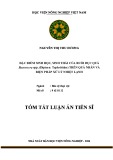
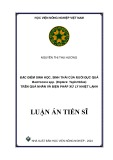

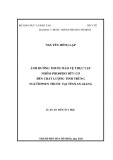



![Đề án Thạc sĩ: Tổ chức hoạt động văn hóa cho sinh viên Trường Cao đẳng Du lịch Hà Nội [Chuẩn nhất]](https://cdn.tailieu.vn/images/document/thumbnail/2025/20251202/kimphuong1001/135x160/91661764646353.jpg)





